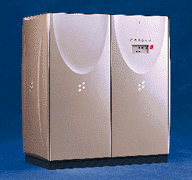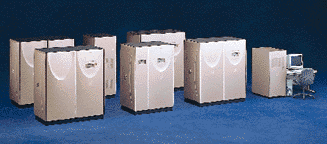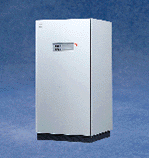Archived content
NOTE: this is an archived page and the content is likely to be out of date.
Fujitsu Mainframe Server GlobalServer GS8800 product information
The GS8800 processing units include the following:
 Single Cluster
Single Cluster- CPU: Central Processing Unit
- MCU: Memory Control Unit
- MSU: Main Storage Unit
- IOP: I/O Processor
- CHU: Channel Unit
- SVP: Service Processor
 Multi-cluster
Multi-clusterIt is also possible to use the SSU (System Storage Unit). The Multi-Cluster Models (GS8800/200-1600) include 2 to 16 processing units and the following:
- CLCU: Cluster Connection Unit
This device, which is crucial to multicluster environments, connects the clusters together and links with the Sure System. It controls communications among clusters. FDDI (100 Mbps) and ATM-LAN (156 MB/sec) are offered as options. - SVPM: Service Processor Manager
This device coordinates hardware controls in multi-cluster environments. The SVPM console allows hardware to be monitored in all clusters. - SSU: System Storage Unit
Located between the main and external storage units, the System Storage Unit (SSU) transfers data between clusters and the SSU at the super high speed of 650 MB per second and has a maximum capacity of 16 GB. In a multicluster environment, the SSU dynamically controls the system structure. It allows for flexible expansion and changes such as resource sharing among clusters, dynamic connection and disconnection of clusters, etc. The SSU is equipped with functions such as duplexing and battery backups to create a trustworthy, highly reliable parallel system.

- OCLS: Optical Channel Link Station
The OCLS is used to dynamically change connection paths between OCLINK channels and peripheral devices at very high speeds. Historically, BMC and optical channels had fixed connections to I/O devices. The OCLS sits between OCLINK channel connections to the channel processor and OCLINK channel connections to I/O controllers and devices. These connections do not need to be one-to-one. Thus a single channel connection to the channel processor may be linked to a number of channel connections to I/O devices and vice versa. This allows efficient channel load distribution and reduces the I/O cabling requirements. It is also possible to carry out maintenance on peripheral equipment or install new equipment without stopping the system in what is known as active maintenance and active inclusion.
